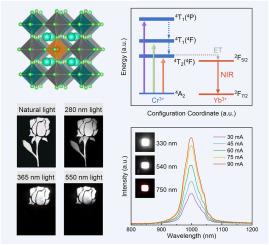Yb3+/Cr3+共掺杂双钙钛矿多波段激发明亮近红外发射极多模态防伪和成像
IF 3.6
3区 物理与天体物理
Q2 OPTICS
引用次数: 0
摘要
近红外(NIR)发光,特别是在700 - 1100nm范围内,由于其深层组织穿透,低散射和非侵入性,在夜视,生物医学成像和防伪方面具有很大的应用前景。Yb3+离子在~ 1000 nm处具有明显的近红外发射,但其奇偶禁止的4f-4f跃迁导致其在紫外-可见光下吸收较弱,激发效率较差。为了克服这些限制,我们报道了一种Cr3+共掺杂策略,以提高水热法合成的无铅双钙钛矿Cs2NaScCl6微晶体中Yb3+的近红外发射效率和激发带宽。Cr3+离子的引入产生了额外的电子态,减小了带隙,并显着拓宽了从紫外到可见光区的激发范围。结合光谱和理论计算表明,从Cr3+到Yb3+的能量转移效率高达45.51%,导致近红外发射强度比单独掺杂Yb3+的样品提高了8.15倍。该共掺杂体系具有高效的多波段激发和较强的近红外发射特性,可用于近红外磷光转换发光二极管和防伪。这项工作为开发高效、宽带可激发的近红外荧光粉和推进无铅光电器件提供了一种有前途的策略。本文章由计算机程序翻译,如有差异,请以英文原文为准。

Multiband excited bright NIR emitter via Yb3+/Cr3+ co-doped double perovskites for multimodal anti-counterfeiting and imaging
Near-infrared (NIR) luminescence, particularly in the 700–1100 nm range, holds great promise for applications in night vision, biomedical imaging, and anti-counterfeiting due to its deep tissue penetration, low scattering, and non-invasive nature. Yb3+ ions feature a sharp NIR emission at ∼1000 nm, but their parity-forbidden 4f-4f transitions lead to weak absorption and poor excitation efficiency under ultraviolet–visible light. To overcome these limitations, we report a Cr3+ co-doping strategy to enhance the NIR emission efficiency and excitation bandwidth of Yb3+ in lead-free double perovskite Cs2NaScCl6 microcrystals synthesized via a hydrothermal method. The introduction of Cr3+ ions generates additional electronic states, reduces the band gap, and significantly broadens the excitation range from the ultraviolet to the visible region. Combined spectroscopy and theoretical calculations demonstrate the energy transfer from Cr3+ to Yb3+ with a high transfer efficiency of 45.51 %, leading to an 8.15-fold enhancement in NIR emission intensity compared to samples doped solely with Yb3+. The co-doped system exhibits efficient multi-band excitation and strong NIR emission, enabling its application in NIR phosphor-converted light-emitting diodes and anti-counterfeiting. This work provides a promising strategy for developing efficient, broadband-excitable NIR phosphors and advancing lead-free optoelectronic devices.
求助全文
通过发布文献求助,成功后即可免费获取论文全文。
去求助
来源期刊

Journal of Luminescence
物理-光学
CiteScore
6.70
自引率
13.90%
发文量
850
审稿时长
3.8 months
期刊介绍:
The purpose of the Journal of Luminescence is to provide a means of communication between scientists in different disciplines who share a common interest in the electronic excited states of molecular, ionic and covalent systems, whether crystalline, amorphous, or liquid.
We invite original papers and reviews on such subjects as: exciton and polariton dynamics, dynamics of localized excited states, energy and charge transport in ordered and disordered systems, radiative and non-radiative recombination, relaxation processes, vibronic interactions in electronic excited states, photochemistry in condensed systems, excited state resonance, double resonance, spin dynamics, selective excitation spectroscopy, hole burning, coherent processes in excited states, (e.g. coherent optical transients, photon echoes, transient gratings), multiphoton processes, optical bistability, photochromism, and new techniques for the study of excited states. This list is not intended to be exhaustive. Papers in the traditional areas of optical spectroscopy (absorption, MCD, luminescence, Raman scattering) are welcome. Papers on applications (phosphors, scintillators, electro- and cathodo-luminescence, radiography, bioimaging, solar energy, energy conversion, etc.) are also welcome if they present results of scientific, rather than only technological interest. However, papers containing purely theoretical results, not related to phenomena in the excited states, as well as papers using luminescence spectroscopy to perform routine analytical chemistry or biochemistry procedures, are outside the scope of the journal. Some exceptions will be possible at the discretion of the editors.
 求助内容:
求助内容: 应助结果提醒方式:
应助结果提醒方式:


